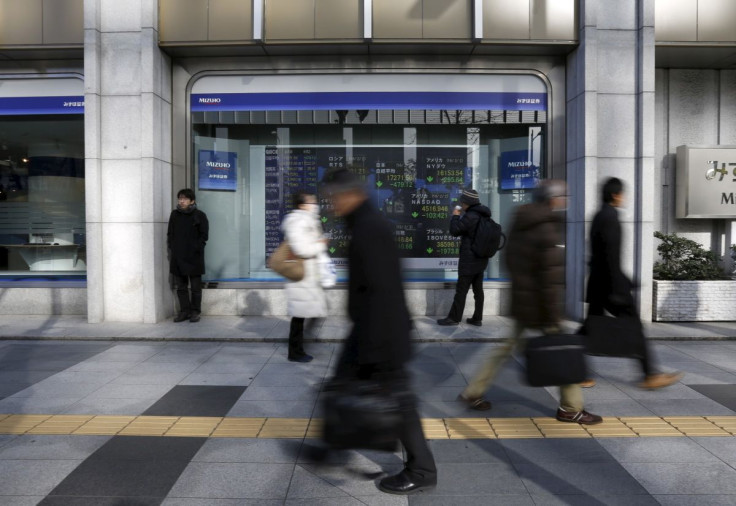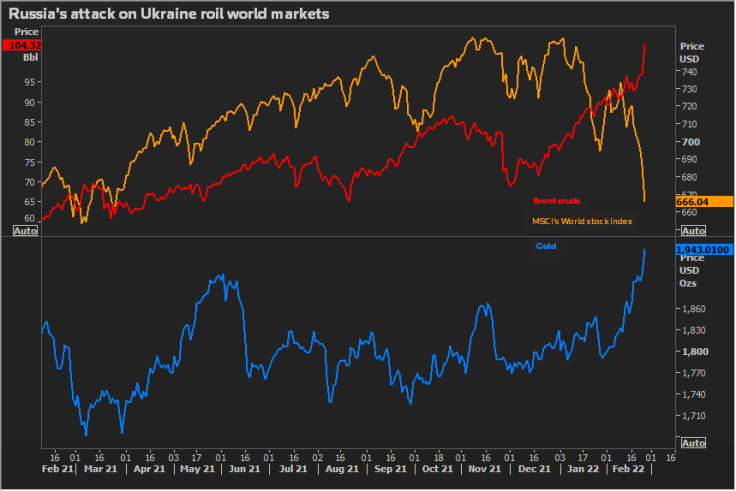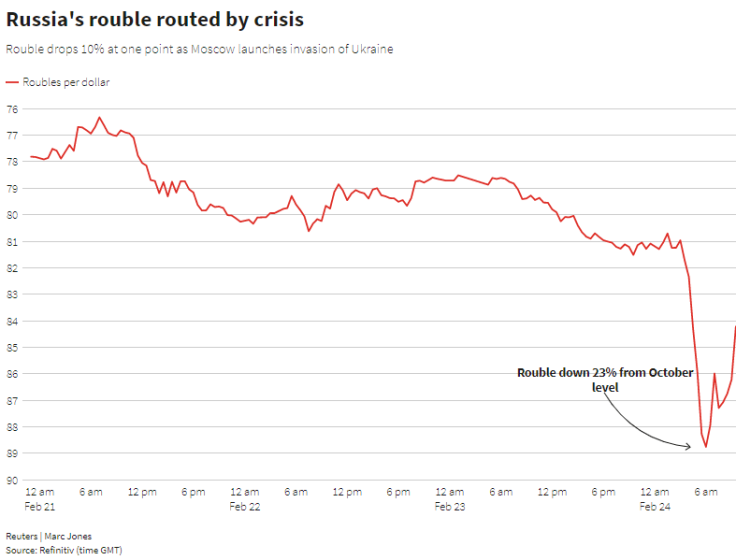Once A Tail Risk, Now A Real Risk, Ukraine Deals Investors A 'Gut Check'

What seemed like a tail risk event for world markets just a few weeks back became reality on Thursday as Russia's attack on Ukraine generated a fresh wave of uncertainty and sent money managers scrabbling to assess the investment implications.
Oil prices broke above $100 a barrel for the first time since 2014, stocks fell, and the rouble hit a record low after Russian President Vladimir Putin authorised what he called a special military operation - labelled by Western governments as a full-scale invasion of Ukraine.
In the United States, the benchmark S&P 500 pared earlier losses and was down around 0.6% in early-afternoon trading. A slide in Treasury yields helped support the tech-heavy Nasdaq Composite Index, which has shuffled between gains and losses and was recently up 0.9%.
"It's a gut check market," said Neil Wilson, chief market analyst at markets.com. "We just don't know what's going to play out over the next few days."
Many investors agreed.
"Heightened volatility on the escalation of the conflict shows markets had not fully priced in the likelihood of deeper conflict," said Mark Haefele, chief investment officer at UBS Global Wealth Management, in a Thursday report.
"We expect continued volatility in the near term as leaders calibrate and announce their response to this escalation."
Graphic: Russia's attack on Ukraine roils world markets -

The knee-jerk market reaction was typical of that seen during past geopolitical flare ups.
Gold prices jumped to their highest in more than a year and the dollar surged more than 1% against a basket of its peers as investors piled into so-called safe haven assets.
Yields on U.S. Treasuries, another popular destination for nervous investors, initially tumbled more than 10 basis points.
With price pressures across major economies already at their highest in decades, the latest events add another layer of complexity and some investors dashed for inflation trades.
In addition to the surge in oil prices, wheat futures jumped to their highest since July 2012, soybean futures gained to a nine-year peak, and corn futures hit an eight-month high. [GRA/]
"Whether there will be a full-blown war or not, the simple strategy is to bet on a spike in inflation," said Yuan Yuwei, a Chinese hedge fund manager at Water Wisdom Asset Management.
"That means buying oil and agricultural products, and shorting consumer shares and U.S. growth stocks."
Russia and Ukraine account for around 29% of global wheat exports, 19% of world corn supplies and 80% of world sunflower oil exports. Military engagement could impact crop movement and trigger a mass scramble by importers to replace supplies from the Black Sea region.
Meanwhile, some buyers of Russian oil have been unable to open letters of credit from Western banks to cover purchases, raising the prospect of energy supply disruptions, Reuters reported.
The heightened geopolitical uncertainty and wild asset price gyrations could also mitigate expected monetary tightening from the Federal Reserve and other central banks in coming months, some market watchers believe.
"Given the shock of today's events, the likelihood that they hold off, or at least slow down, the tightening of monetary policy has probably increased," analysts at Capital Economics wrote.
Investors were watching what further sanctions will follow preliminary ones already announced by the United States, the European Union, Britain and Japan.
OPPORTUNITY?
For some investors the sharp equity market falls offered a buying opportunity.
"Most geopolitical events are sharp, but short-lived with volatility creating opportunity," said Cliff Hodge, chief investment officer for Cornerstone Wealth.
UBS' Haefele, meanwhile, noted that Russia has a strong economic interest in continuing to sell its energy and other commodity exports to Europe, with nearly 38% of its 2020 exports going to the European Union.
"The importance of this trade relationship could weigh against a long-lasting military engagement," he wrote.
Some investors were also looking at assets linked to Ukraine and Russia, which have been hit hard in recent days.
One portfolio manager at a U.S-based asset manager, who asked not to be named, reckoned Ukraine's beaten-down bonds were a bargain "unless Putin fully occupies Ukraine."
The premium demanded by investors to hold Ukrainian debt relative to U.S. Treasuries soared to 15 percentage points - the widest since the country underwent a debt restructuring in 2015.
Russian assets also took a beating - the dollar-denominated RTS stock index crashed 40% to 489 points, its lowest since 2016, while yields on Russian sovereign bonds soared. But bargain hunters were not expected to rush in.
"Buying the dip may be the right response to geopolitics but it's not necessarily true for the part of the world where the fire is actually burning," said Dirk Willer, head of global macro and asset allocation at Citi.
Graphic: Rouble plunges as Russia launches invasion on Kyiv -

© Copyright Thomson Reuters 2024. All rights reserved.




















